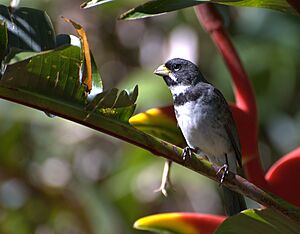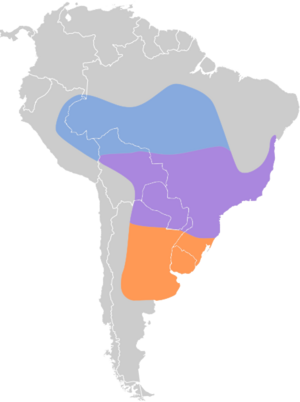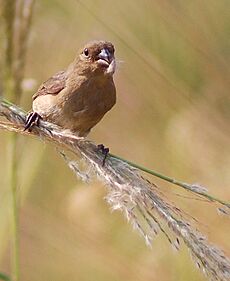Double-collared seedeater facts for kids
Quick facts for kids Double-collared seedeater |
|
|---|---|
 |
|
| Male in Brazil | |
| Conservation status | |
| Scientific classification | |
| Genus: |
Sporophila
|
| Species: |
caerulescens
|
 |
|
The double-collared seedeater (Sporophila caerulescens) is a small bird that belongs to the Thraupidae family. This family includes many types of tanagers and finches.
You can find this bird in several South American countries. These include Argentina, Bolivia, Brazil, Paraguay, Peru, and Uruguay. It also lives along the southern edge of Colombia, near the Amazon River.
These birds like to live in places with lots of bushes and shrubs, especially in warm, wet areas. They also enjoy pastureland (fields where animals graze) and even places where forests used to be but are now changed by people.
What Does It Look Like?
The double-collared seedeater is a dimorphic bird. This means the male and female birds look different from each other.
The male is quite colorful. It has a gray head and back. Its throat has a black collar, and just below that, there's another black band across its upper whitish chest. It has gray legs and a medium-length tail. Its strong, thick beak is perfect for eating seeds.
The female, on the other hand, is less colorful. She has more plain, brownish feathers. This helps her blend in with her surroundings, especially when she is nesting.
Where Does It Live?
This bird's home range stretches across a large part of South America. It lives from central Argentina, east of the Andes mountains, all the way north through Bolivia and Paraguay. It also spreads northeast into south-central Brazil and along the southeast coast of Brazil.
During the austral winter (which is winter in the Southern Hemisphere), these birds often move into the Amazon Basin. The double-collared seedeater is only found in the southern Amazon Basin. The mighty Amazon River acts as its northern border.
In the western part of the Amazon Basin, you can find it in eastern Peru, especially near the Ucayali River. It mostly stays on the eastern bank of this river, which flows north. In the southeastern Basin, it lives from the Cerrado region into the upper parts of the Araguaia-Tocantins River system.



